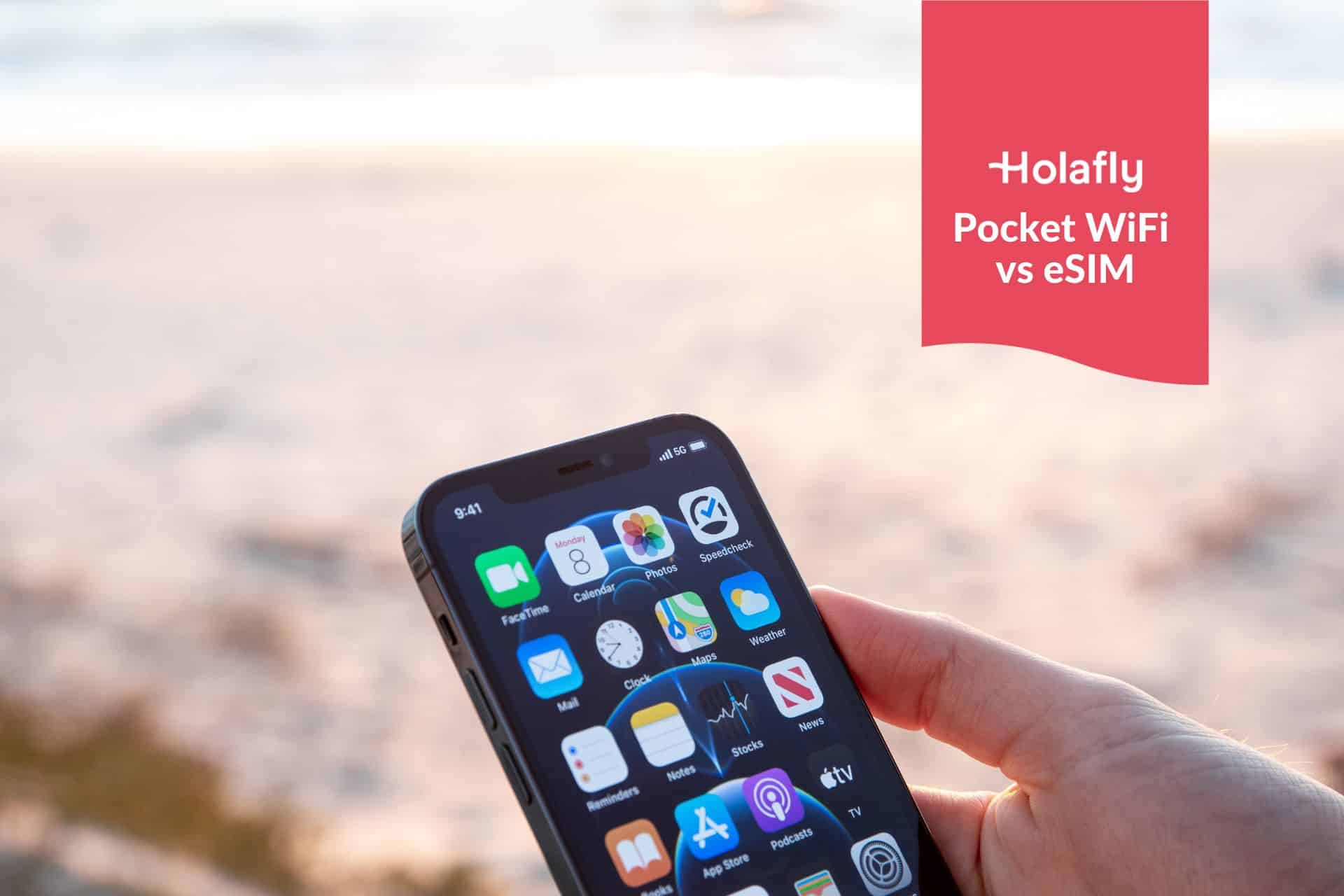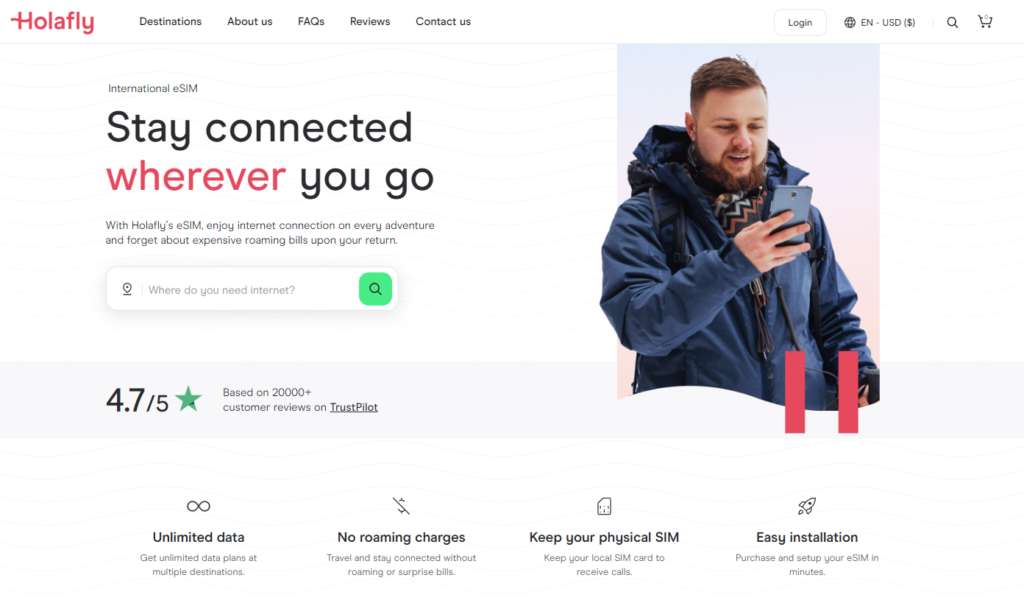eSIM vs. pocket WiFi: Which one is better?
Both eSIM and pocket WiFi allow you to stay connected on the go, but both are very different services. Follow along to learn which one is right for you.
Looking for the best way to stay connected when traveling abroad? Pocket WiFi and eSIMs are both popular options, but only one can be considered the best. Follow along to learn all you need to know about the eSIM vs. pocket WiFi comparison, including pricing, convenience, and ease of use.
Choose the most convenient way to stay connected
Get an eSIM from Holafly for unlimited data anywhere you go. Use code MYESIMNOW5 at checkout for 5% off your order.



 +1M
+1M
With Holafly, you save +30% compared to roaming fees
Plans that may interest you
What is pocket WiFi?
Pocket WiFi, also known as MiFi, portable WiFi, or mobile hotspot, is a portable router that allows you to connect multiple devices to a single WiFi network. It uses mobile data from a physical SIM card or an eSIM mobile data, which it then turns into a WiFi network, much like setting up a hotspot on your mobile phone.
You can either buy a pocket WiFi device and then buy separate data plans whenever you travel, or you can rent the device that’s already set up with a data plan for the rental period. The devices are battery powered, so you’ll have to charge the portable WiFi device before using it and after each day of usage.
Most pocket WiFi batteries last 8-12 hours, so make sure to only keep the device on when you’re actually using it to avoid running out of charge. Depending on the device and the provider, you’ll be able to connect 5-10 devices at once.

Pros and cons of pocket WiFi
Pros
- Ability to keep multiple devices connected at all times
- Reliable coverage in most areas
- Option to own or rent the device
Cons
- Extra cost for renting or buying the device
- Need to have the device with you at all times
- Limited battery life
- Extra fees, such as shipping and insurance, can be attached to rentals
What is an eSIM?
An eSIM is a virtual SIM card technology that allows you to get an internet connection without the need for any additional devices or physical SIM cards. All you need is an eSIM plan and an eSIM-compatible device, which shouldn’t be an issue, since most modern phones support eSIM technology nowadays.
You can purchase, set up, and activate your eSIM in a matter of minutes and enjoy instant internet access wherever you are. There are plenty of eSIM providers on the market today, so you’ll always be able to find one that matches your price and data requirements.
On top of that, most eSIM plans allow data sharing, so you can turn your phone into a mobile hotspot and share data to other devices. Though it’s worth mentioning that the amount of data you can share is often limited, so you might not be able to keep five or more devices connected at all times without reaching the limit.

Pros and cons of eSIM
Pros
- Doesn’t require additional devices or cards
- Allows sharing data to other devices
- Usually cheaper than pocket WiFi
- Many providers and plans to choose from
- Can be set up online within minutes
Cons
- Data sharing is often limited
- Not all devices are compatible with eSIMs
eSIM vs. pocket WiFi comparison
Now that you know the basics about pocket WiFi devices and eSIM cards, let’s take a look at how they compare when it comes to pricing, convenience, and other features.
Purchase and activation process
One of the biggest differences between eSIMs and pocket WiFi is the process from the beginning of purchase to the moment you start using your mobile internet. You can buy and activate an eSIM in a few minutes, while the same process can take weeks for a pocket WiFi device.
With an eSIM, you’ll receive a QR code in your email as soon as you buy a plan. Scan the QR code and follow the simple instructions to activate your eSIM to enjoy internet access within minutes.
With pocket WiFi, the delivery alone can take up to a week. And while rentals come ready for use, a personal device doesn’t come with mobile data, so you’d have to buy a new data-only SIM every time you travel.
Pricing
If we were to compare unlimited data plans, you can get an eSIM for around $6/day for short-term plans, but you do get better value for money with longer plans. For example, Holafly’s eSIM for France costs $74.90 for 30 days, which averages out to $2.50/day for the plan period.
As for pocket WiFi rental, you can expect to pay around $8-15/day for unlimited data. If you own the device, you only need to buy a data SIM card, which usually costs about as much as an eSIM.

Additional costs
With pocket WiFi, you’ll need to have your device delivered to you and returned to the provider. This alone can quickly add $10-30 or even more to your bill. On top of that, if you lose or damage your device, you’ll have to pay a fine that’s usually in the $100-300 range.
When it comes to eSIMs, the only unexpected cost can be a top-up if you’re using a fixed data plan. However, there are no additional costs as long as you use unlimited data plans or monitor your data usage carefully on fixed plans.
Convenience
Both pocket WiFi and eSIM are convenient once you start using them. However, you still need to carry and take care of an extra device everywhere you go when using pocket WiFi. This also means that you can lose it, have it stolen, or drop and damage it, which ends up costing you.
An eSIM is completely digital, so all you need to worry about is not losing your mobile phone. It’s embedded in your device, meaning that there’s no way to lose or damage it.
eSIM vs. Pocket WiFi: Overview
Now that we’ve covered all the bases for the eSIM vs. pocket WiFi comparison, let’s sum up the key points to help you choose the service that fits you best.
| Features | eSIM | Pocket WiFi |
| Price | $2-6/day | $8-15/day |
| Time from purchase to use | 3-5 minutes | 3-5 work days |
| Internet connection sharing | Yes | Yes |
| Flexible plans and rates | Yes | No |
| Immediate delivery | Yes | No |
| Physical SIM required | No | Yes |
| Shipping costs | No | Yes |
| Fee in case of loss | No | Yes |
Looking at the table above, it’s pretty clear that eSIM is both cheaper and more convenient than pocket WiFi. The only good reasons for using pocket WiFi nowadays are if you don’t have an eSIM-compatible device or if you absolutely must keep multiple devices connected to the same network at all times.
eSIM vs. pocket WiFi: Which one should you choose?
The information above should be enough to guide you on the right track when choosing between an eSIM and pocket WiFi. Both alternatives have a place in the connectivity market, otherwise they wouldn’t be a part of it.
That said, if you simply need mobile internet on the go during your travels, an eSIM will usually end up being cheaper and easier to get, all while maintaining fast internet speeds pretty much anywhere in the world.
FAQs
Depending on your pocket WiFi data plan, you’ll be able to connect anywhere between 5 and 10 devices to the WiFi network at a time.
Some pocket WiFi providers have physical pick-up and drop-off locations in popular airports or other locations frequented by tourists. Others, however, only offer mail or courier deliveries, which can add to the price of your pocket WiFi rental.
The battery on pocket WiFi devices usually lasts 8 to 12 hours, though there are some devices that can be used for longer periods without charging.
All you need to use an eSIM is an eSIM-compatible phone that’s unlocked for use abroad and an eSIM data plan.
In most cases, eSIM is a better option than portable WiFi due to its pricing and convenience. That said, pocket WiFi can be a good option if your phone doesn’t support eSIMs or if you need to keep multiple devices connected to WiFi at all times.






































 Pay
Pay  Language
Language  Currency
Currency 


















 No results found
No results found





